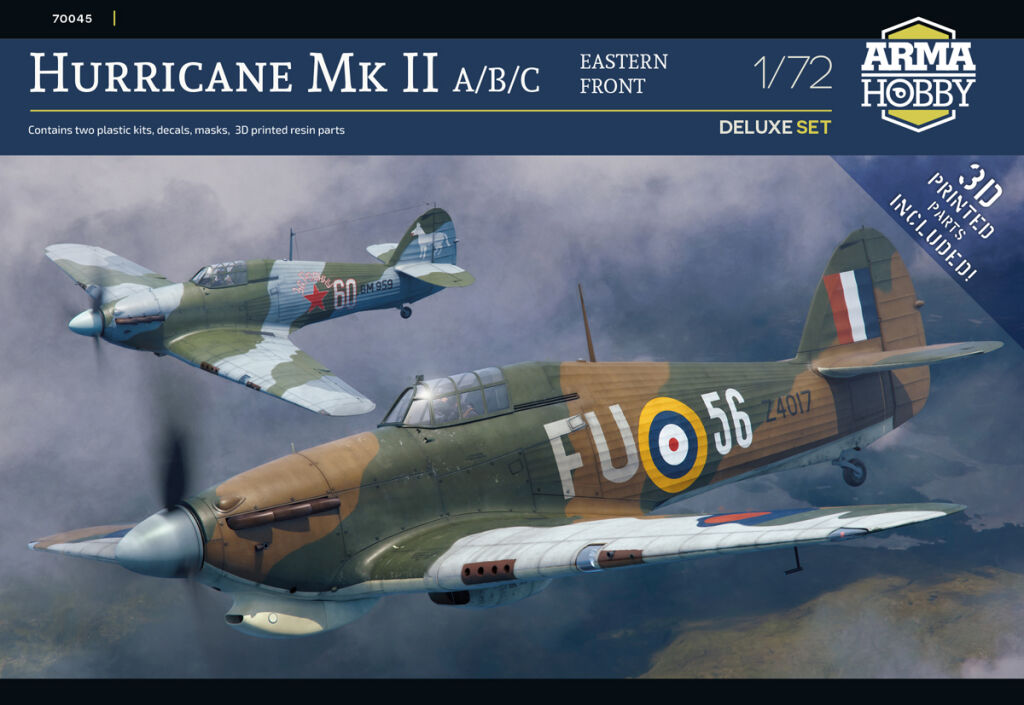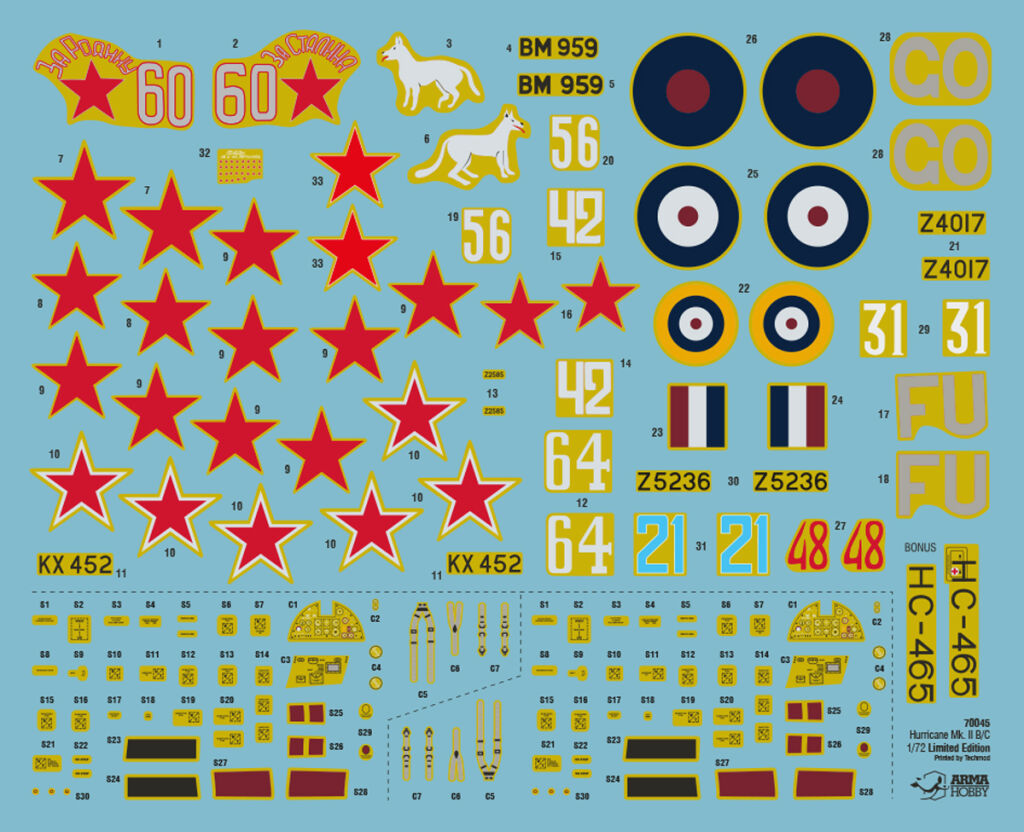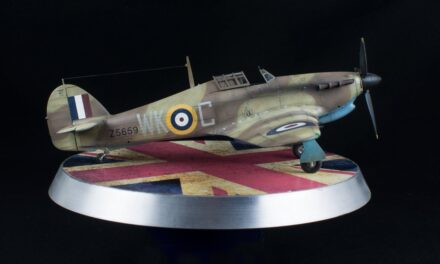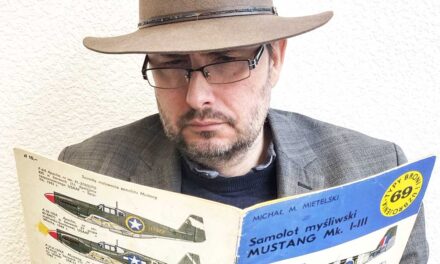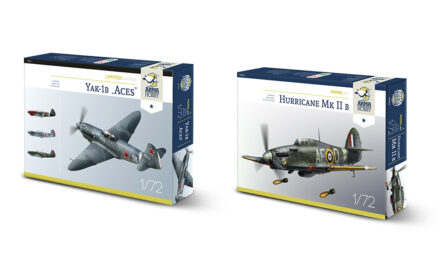The present article was occasioned by the difficulty in interpreting the camouflage of Hurricane Z2585/42, for which decals and a proposed paint scheme have been included in the “Eastern Front” kit. The aircraft has been the subject of several different studies, but it is only by studying its history and the camouflage tests which it underwent in the spring of 1941 in greater detail that we may better understand its appearance.
The camouflage tests that led to the implementation of the Day Fighter Scheme were first mentioned by Michael Bowyer in “Fighting Colours” in 1969. During his visits to Duxford in the spring of 1941, the author of this classic book observed a Hurricane from No. 56 Squadron RAF whose camouflage was completely different from the then common Temperate Land Scheme. Writing his work more than 20 years later, he based his description of these paint schemes in part on photographs from the resources of the Imperial War Museum (CH 4538-4550), which, however, show the test aircraft as they appeared in December 1941, that is, several months after the conclusion of the tests, with changes introduced following their completion.
The fullest attempt at systematizing the available body of knowledge was made by Paul Lucas in “Britain Alone”, this time with the inclusion of archival documents, while an important clue – a scan of a Fighter Command HQ telegram dated 7 June 1941, can be found in a brochure published by the North Weald Airfield Museum. These sources and the photographs that I was able to find have allowed me to present a more comprehensive description of the process that led to the emergence of the Day Fighter Scheme.
The Beginnings of the Experiments
The reason for the decision to develop a new paint scheme was the observation that the Temperate Land Scheme used on British fighters worked effectively at low altitudes and against the backdrop of the ground, but was far too dark above 10,000 feet. At the same time, it was noted that the grey-painted Bf 109s were more difficult to spot at higher altitudes and when flying over the sea. Given that the planned offensive operations were to be carried out at high altitudes and required overflying both the English Channel and the North Sea, a new camouflage was considered essential.
The first trials, using two Spitfires, X4815 and X4816, were conducted at the AFDU (Air Fighting Development Unit) in Duxford in April 1941. Both the colours previously used by Coastal Command and the Fleet Air Arm were evaluated at the time, as well as the brand new schemes mixed specifically for the tests. Initially, X4815 was given a camouflage similar to that used by the Germans, that is, irregular small spots spray-painted in Olive Grey on the fighter’s upper surfaces, which were covered with Sky Grey. The underside was to be coloured Sky Blue. The colour known as “Olive Grey” never became a standard element of RAF paint schemes, while its exact tone is impossible to reproduce. It only appears in the context of these tests, and was meant to be intermediate between Light Slate Grey and Dark Sea Grey. The camouflage consisting of irregular small patches, so-called mottling, was soon replaced by the typical deforming speckled camouflage based on Medium Sea Grey and the aforementioned Olive Grey. Mottling does not give a clear deforming effect to an aircraft’s silhouette, and this may have been the reason for the return to the traditional arrangement of camouflage patches.
Initially, a new special colour was tested only on the underside of X4816; next, two shades of grey, in the form of blotches coloured Dark Sea Grey and Medium Sea Grey, were applied to the upper parts of the airframe, while the underside was covered with Sky Grey.
This phase of testing confirmed the benefits of using grey and relatively light colours on the upper surfaces of aircraft which operated high above the clouds in light with a more intense ultraviolet spectrum, and at the same time the need to paint undersides with colours darker than Sky and Sky Blue. At high altitudes, Sky and Sky Blue were sparklingly bright and thus completely ineffectual. The aircraft were then additionally illuminated by light reflected from the lower layers of the atmosphere, and this significantly changed the requirements for camouflage. An optimal combination had to be developed, and this work was entrusted to No. 56 Squadron RAF stationed at North Weald.
Testing With No. 56 Squadron RAF
This second phase of testing commenced on 10 May 1941 and involved two Hurricane Mk. IIbs: Z2898 and Z2983. According to Paul Lucas, the fighters were to be given a camouflage comprising Medium Sea Grey and Olive Grey, with the undersides coloured Sky Blue. The quick identification elements, namely the spinner and the stripe in front of the tail unit, were also painted over. A clue pointing to the utilization of these colours in the first stage of testing is that large quantities of paint of these very colours were delivered to the unit only a few days prior.
Paul Lucas’ reconstruction of the first trial Hurricane camouflage patterns was based solely on documents, but it appears that he reproduced the appearance of the test aircraft quite well. One of them was photographed, and while the image partially confirms his conclusions, it also reveals important differences.
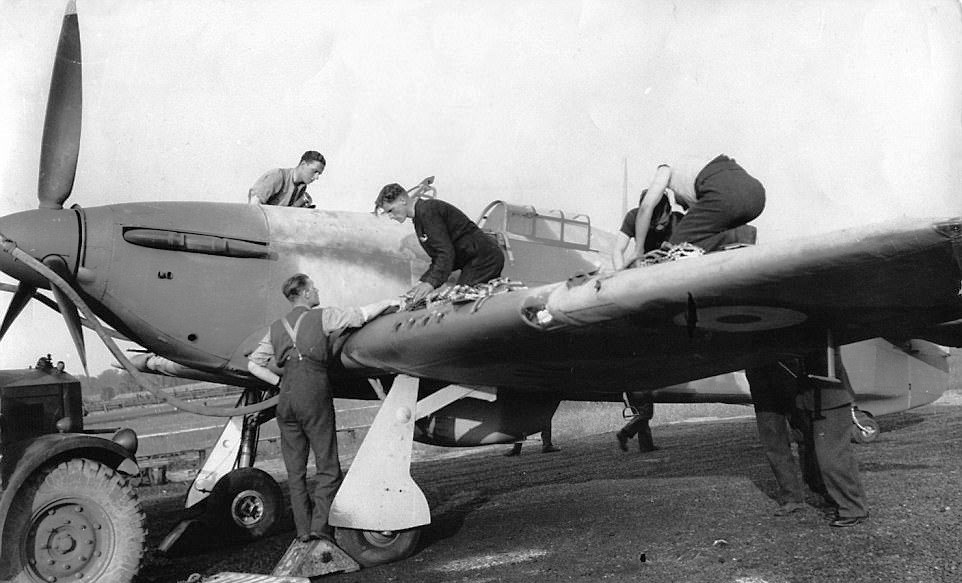
One of the first Hurricanes to undergo experiments at No. 56 Squadron RAF. Two shades of grey over the entire airframe. A dark camouflage patch is visible on the underside of the wing. The entire underside of the front part of the fuselage was also painted in a dark colour, and its border is visible on the radiator housing. Photo via F. Grabowski
The photograph itself is known, but has never been connected with the camouflage tests. It most probably depicts one of the aircraft of the first pair, painted in two contrasting colours and without a stripe on the rear section of the fuselage, with a spinner in the colour of the camouflage, and with its serial number painted over. What is most surprising is how the underside has been painted, with a speckled camouflage identical to that covering the upper portion of the airframe. In my opinion, all of the fighter’s surfaces were painted in only two shades of grey (Medium Sea Grey and Olive Grey) in what is known as a “wrap around” camouflage. The cockpit canopy frame was left in its original colour, Dark Green, and may be viewed as a hint to the intensity of the Olive Grey. This is on the whole consistent with what Paul Lucas deduced, except for the colour applied to the undersides and the distribution of blotches, which does not correspond either to the regulation scheme A or its mirror image scheme B. This is important because the same different arrangement of camouflage blotches appears in other photographs of the fighters that passed through the tests at Duxford.
On 11 May, the aforementioned pair was joined by Z2585.
Whereas on 26 May, three fighters: Z2697, Z2767 and Z2586, flew off to for Duxford; this time, however, the tests lasted longer. The aircraft returned to North Weald only on 28 May.
Once again, there was a two-week break in testing, perhaps in order to process the gathered data, while on 7 June the entire unit took off from its home base to participate in trials.
On the same day, Fighter Command HQ sent a telegram informing, among others, the Air Ministry and subordinate Fighter Group Commands that testing of a new camouflage was under way. Thanks to this document, we know which paint scheme was being evaluated at the time: The colours on the upper surfaces were Medium Sea Grey and Smoke Grey, while the underside was uniformly painted Sky Blue, rather than bi-coloured. The yellow border on the fuselage cockade was narrower, and the size of the code letters varied (the photograph of CH 17129 from the collections of the Imperial War Museum shows the squadron code letters US, which were half the size). There were no quick identification elements in the form of a stripe in front of the tail unit or a Sky-coloured spinner.
Yet again, the Smoke Grey poses a problem. It was undoubtedly a different colour from the Olive Grey mentioned in connection with the May tests. Olive Grey is a green-grey colour, while Smoke Grey is more bluish-grey, and it is very possible that already then this shade was very close to what later became known as Ocean Grey. It should be assumed that various colours were used in the search for the optimum solution, and that some were mixed on site and outside of Air Ministry specifications. It was probably felt that Olive Grey did not contrast sufficiently with Medium Sea Grey, and that the desired silhouette deformation effect was not strong enough, or that the camouflage was by and large too light for lower altitudes. Paul Lucas further states that the colours used on aircraft operating over the sea, namely, Dark Sea Grey and Extra Dark Sea Grey, were also applied as a second, darker grey. We may assume that the trials started with the lightest colours, best suited for higher altitudes, applied to the upper surfaces, and that a compromise was sought during the second stage by testing increasingly darker shades of grey. Whereas Medium Sea Grey was retained as the second colour.
The document dated 7 June 1941, referred to above, does not mention a “wrap around” camouflage, and we may infer that by this time the method had been abandoned and a decision taken to select a suitable colour for the underside; however, it would seem that the question was still open at this stage of testing. In accordance with the theoretical assumptions and the results of the trials carried out so far, it was to be a darker colour than Sky. We may mention here that aircraft operating at high altitudes had their undersides painted with PRU Blue, a colour much darker than Sky.
The unit’s documents inform us that test flights were still being conducted on 13 June, while the last entry in the ORB relating to camouflage testing is dated 24 July. However, after 7 June, when the entire squadron received experimental and as yet non-uniform paint schemes, each flight became connected with the ongoing camouflage trials. M. Bowyer’s testimony indicates that the unit had aircraft in paint schemes from different stages of testing at the same time. An analysis of the ORB confirms this observation, because instead of repainting one aircraft repeatedly, successive fighters were taken for consecutive tests. In the unit, aeroplanes with different colour schemes flew side by side.
During the trials and a few weeks after their completion, the Hurricanes of No. 56 Squadron RAF were easily distinguishable by their colour; this all changed, however, with the development of a new paint scheme, which formed the basis for the order of 8 August 1941 introducing the Day Fighter Scheme. It is not known when exactly the decision was made to apply a 7:1 mix of Medium Sea Grey and Night as the dark-grey colour, which was soon named Ocean Grey. The Night colour had a blue component, which gave the new mix a bluish hue. Interestingly, the choice of this mixture may also have had an economic justification. Whereas Ocean Grey utilized paints that were already available and did not require new dyes; by all accounts, it acquitted itself well, for it was retained in the camouflage schemes of British aircraft for years after the war.
The Polish Episode and Traces in the Snow
While only one photograph, discussed above, is known from the time of the experiments conducted at No. 56 Squadron RAF, photographs of two other participating Hurricanes, which were handed over to No. 316 (Polish) Squadron RAF in late June, have been found.
The first was Z2405/SZ-S. I must add here that the serial number of this aircraft remains uncertain. It is not visible in the photograph, and was in fact obtained from the unit’s documentation, according to which this serial was assigned an individual letter “S”. However, doubts remain as to whether Z2405 was consistently listed in the ORB of No. 316 (Polish) Squadron RAF as a Mk. IIa, while the aircraft in the picture is shown armed with 12 machine guns. A possible explanation is that this was one of the Hurricanes that were converted to the Mk. IIb version, but it is also not inconceivable that it was one of the two Mk. IIbs taken over from No. 56 Squadron RAF (Z3573 or Z3586).

Z2405/SZ-S serving with No. 316 (Polish) Squadron RAF. An aircraft passed on from No. 56 Squadron RAF in the last decade of June 1941. At this stage of testing, various shades of grey were applied; it is likely that the fighter has a Medium Sea Grey and Smoke Grey camouflage. The underside is not visible, but the dismantled radiator shroud lying under the left wing has a darker camouflage colour, thereby suggesting at least a partial retention of the two-tone camouflage scheme. Photo via P. Sikora
This fighter and the previously described aeroplane had one thing in common, namely, an atypical distribution of camouflage patches. The darker grey colour is most likely Smoke Grey, which was tested immediately before the fighter was passed on to the Polish unit. The narrow yellow border surrounding the fuselage cockade – referenced in the telegram of 7 June – is clearly visible. The rapid identification elements, Sky-coloured, have returned, and were probably added already at No. 316 (Polish) Squadron RAF. The dark radiator shroud, located beneath the wing, is a left-over of the two-tone paint scheme applied to the undersides. The fact that the aircraft in this camouflage had code letters, the squadron emblem and the Polish checkerboard allows us to infer that it served with the unit without any significant repainting.
The second fighter to have photographical documentation is Z2585. There are no photographs from its period of service with the Polish squadron, however we do have pictures of the fighter taken by the Finns in the winter scenery of February 1942. The aircraft was handed over to No. 316 (Polish) Squadron at the same time as Z2405, and was probably also painted with two shades of grey; it served without any change of paint scheme until mid-August, when the order was received to introduce the Day Fighter Scheme. Then, the Medium Sea Grey blotches were painted over with regulation Dark Green, leaving the dark grey blotches from the period of testing while with No. 56 Squadron RAF unchanged. This is a similar image to the photographs of aircraft from No. 56 Squadron RAF from the resources of the Imperial War Museum (for example, CH 4543), which were taken in December 1941. There is practically no contrast between the aircraft’s dark grey colour and the Dark Green visible on the orthochromatic film. This suggests that it was a neutral dark grey, without the blue component present in Ocean Grey. It could have been Extra Dark Sea Grey, which looks similar in photographs from the period, or one of the mixes used in the tests, the shades of which cannot be identified in the absence of documentation of the tests described here. Typical Day Fighter Scheme colours, and predominantly Dark Green, were used to paint the Polish checkerboard on the engine side panel, the squadron emblem behind the cockpit, and the identification marks and code letters. The only places where Ocean Grey was used were the painted over letters of individual aircraft, which were clearly brighter than the rest by virtue of having a blue component, to which orthochromatic films react most strongly. It is worth adding here that the aircraft sent to the USSR usually had their RAF markings painted over and were adorned with red stars even before being disassembled and packed into crates, and – although by no means the rule – this is what most probably happened with Z2585. This may be evidenced by the fact that the stars were painted on the upper wing surfaces, which was not the usual practice in Soviet aviation.



Z2585/42, ex SZ-X. The aircraft was serving with a Polish unit at the time of the official introduction of the Day Fighter Scheme, and the Medium Sea Grey on its upper surfaces was painted over with Dark Green in mid-August 1941. Photographs of SA-KUVA from Carl-Fredrik Geust
Although the lack of contrast between individual camouflage colours renders an assessment difficult, a closer look at the photographs allows us to state with complete certainty that, once again, the distribution of blotches is clearly different from the factory pattern – the same as on the test aircraft painted at No. 56 Squadron RAF.
Nevertheless, the above reconstruction of the course of the camouflage tests conducted in the spring of 1941, described here on the example of photographs, is still only an outline, which will perhaps be supplemented and precised over time. A more distant aim is to offer modellers in future a Hurricane model kit with comprehensively documented experimental paint schemes, which would doubtless be highly original when compared to the standard factory patterns.
I would like to thank Franciszek Grabowski for his cooperation, and Piotr Sikora and Carl-Fredrik Geust for the provision of photographs.
References
- Operations Record Books, Nos 56 and 316 Squadrons RAF
- M. Bowyer “Fighting Colours”
- P. Lucas “Britain Alone. June 1940 to December 1941”
- J. Goulding, R. Jones “Camouflage & Markings”
- https://www.eppingforestdc.gov.uk/northweald/wp-content/uploads/sites/6/2020/08/Spirit-of-North-Weald-Booklet-4.pdf
See also:
- Buy Hurricane Mk IIa/b/c Eastern Front Deluxe Set online at Armahobby.com!
1/72 Hurricane Mk IIa/b/c Eastern Front Deluxe Set – malowania w zestawie
Hurricane Mk IIa/b/c Eastern Front 1/72 Deluxe Set – instrukcja modelu 70045
Model maker for 45 years, now rather a theoretician, collector and conceptual modeller. Brought up on Matchbox kits and reading "303 Squadron" book. An admirer of the works of Roy Huxley and Sydney Camm.
This post is also available in:
 polski
polski


